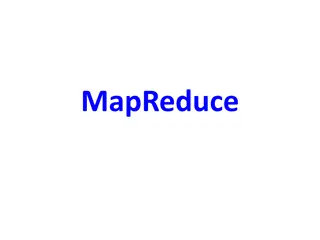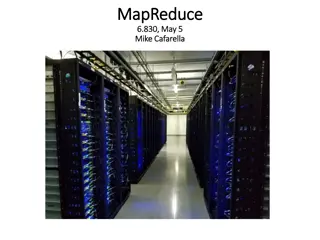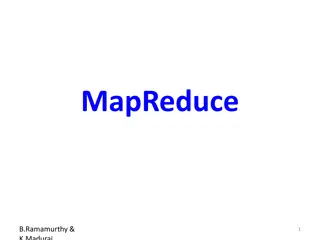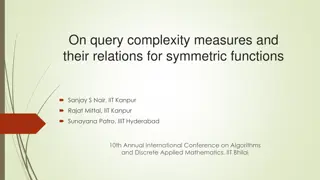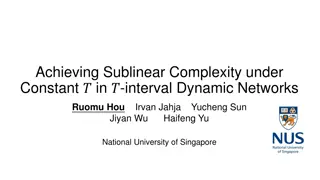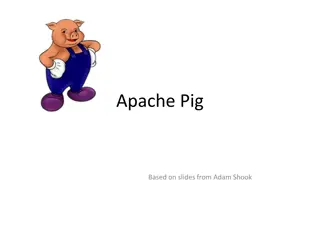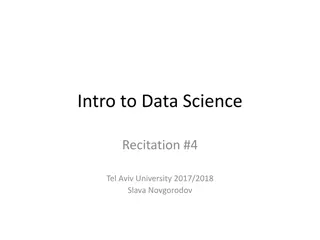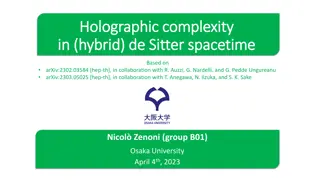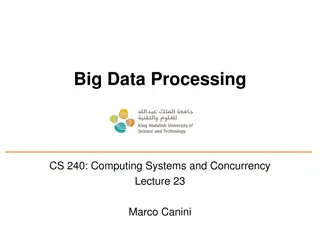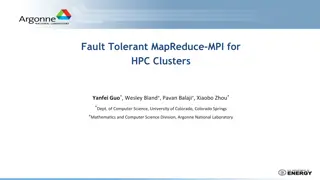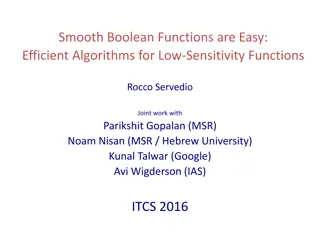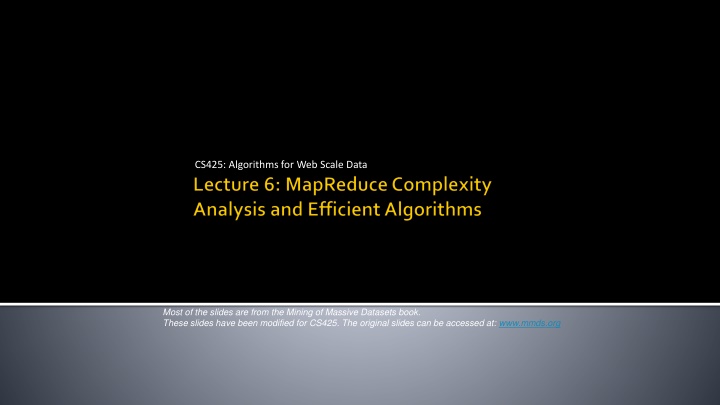
Algorithms for Web-Scale Data: Communication and Example Scenarios
Explore the communication cost model and examples like join with MapReduce and single-step matrix-matrix multiplication for web-scale data algorithms. Understand replication rate, reducer size, and their impact on parallelism. Discover how data is processed and shared efficiently in large-scale web environments.
Download Presentation

Please find below an Image/Link to download the presentation.
The content on the website is provided AS IS for your information and personal use only. It may not be sold, licensed, or shared on other websites without obtaining consent from the author. If you encounter any issues during the download, it is possible that the publisher has removed the file from their server.
You are allowed to download the files provided on this website for personal or commercial use, subject to the condition that they are used lawfully. All files are the property of their respective owners.
The content on the website is provided AS IS for your information and personal use only. It may not be sold, licensed, or shared on other websites without obtaining consent from the author.
E N D
Presentation Transcript
CS425: Algorithms for Web Scale Data Most of the slides are from the Mining of Massive Datasets book. These slides have been modified for CS425. The original slides can be accessed at: www.mmds.org
Communication Cost Model The model we will use: Output sizes are ignored If the output is large, it s likely that it will be input to another stage The real outputs are typically small, e.g. some summary statistics, etc. Reading from disk is part of the communication cost e.g. The input to the map stage can be from the disk of a reduce task at a different node Analysis is independent of scheduling decisions e.g. Map and reduce tasks may or may not be assigned to the same node. Communication cost = sum of input sizes to each stage Input Reduce Map Reduce Output Map 3 CS 425 Lecture 6 Mustafa Ozdal, Bilkent University
Definitions: Replication Rate & Reducer Size Replication rate: Avg # of key-value pairs generated by Map tasks per input The communication cost between Map and Reduce is determined by this Donated as r Reducer size: Upper bound for the size of the value list corresponding to a single key Donated as q Choose q small enough such that: 1. there are many reducers for high levels of parallelism 2. the data for a reducer fits into the main memory of a node Typically q and r inversely proportional Tradeoff between communication cost and parallelism/memory requirements. 4 CS 425 Lecture 6 Mustafa Ozdal, Bilkent University
Example: Join with MapReduce Map: For each input tuple R(a, b): For each input tuple S(b, c): Replication rate: Generate <key = b, value = ( R , a)> r = 1 Generate <key = b, value = ( S , c)> Communication cost: Reduce: Input: <b, value_list> In the value_list: Pair each entry of the form ( R , a) with each entry ( S , c), and output: <a, b, c> 2(|R|+|S|) Reducer size (worst case): q = |R| + |S| 5 CS 425 Lecture 6 Mustafa Ozdal, Bilkent University
Example: Single-Step Matrix-Matrix Multiplication Assume both M and N have size nxn Map(input): for each mij entry from matrix M: for k=1 to n generate <key = (i, k), value= ( M , j, mij) > for each njk entry from matrix N: for i=1 to n generate <key = (i, k), value= ( N , j, njk) > Replication rate: r = n Communication cost: 2n2 + 2n3 Reduce(key, value_list) sum 0 for each pair (M, j, mij) and (N, j, njk) in value_list sum += mij . njk output (key, sum) Reducer size: q = 2n 6 CS 425 Lecture 6 Mustafa Ozdal, Bilkent University
A Graph Model for MapReduce Algorithms Define a vertex for each input and output Inputs Outputs Define edges reflecting which inputs each output needs Every MapReduce algorithm has a schema that assigns outputs to reducers. Assume that max reducer size is q. Assignment Requirements: 1. No reducer can be assigned more than q inputs. 2. Each output is assigned to at least one reducer that receives all inputs needed for that output. 7 CS 425 Lecture 6 Mustafa Ozdal, Bilkent University
Example: Single-Step Matrix-Matrix Multiplication We have assigned each output to a single reducer. The replication rate r = n The reducer size q = 2n 8 CS 425 Lecture 6 Mustafa Ozdal, Bilkent University
Nave Similarity Join Objective: Given a large set of elements X and a similarity measure s(x1, x2), output the pairs that have similarity above a given threshold. Locality sensitive hashing is not used for the sake of this example. Example: Each element is an image of 1M bytes There are 1M images in the set About 5x1011 (500B) image comparisons to make 10 CS 425 Lecture 6 Mustafa Ozdal, Bilkent University
Similarity Join with MapReduce (First Try) Let n be the # of pictures in the set. Map: for each picture Pi do: for each j=1 to n (except i) generate <key = (i,j), value = Pi> Replication rate r = n-1 Reducer size q = 2 Communication cost = n + n(n-1) # of reducers = n(n-1)/2 Reduce (key, value_list) compute sim(Pi, Pj) output (i,j) if similarity is above threshold 11 CS 425 Lecture 6 Mustafa Ozdal, Bilkent University
Example: 1M pictures with 1MByte size each Communication cost: n(n-1) pictures communicated from Map to Reduce total # bytes transferred = 1018 Assume gigabit ethernet: time to transfer 1018 bytes = 1010 seconds (~300 years) Replication rate r = n-1 Reducer size q = 2 Communication cost = n + n(n-1) # of reducers = n(n-1)/2 12 CS 425 Lecture 6 Mustafa Ozdal, Bilkent University
Graph Model Our MapReduce algorithm: One reducer per output. Pi must be sent to each output. Replication rate r = n-1 Reducer size q = 2 What if a reducer covers multiple outputs? 13 CS 425 Lecture 6 Mustafa Ozdal, Bilkent University
Graph Model: Multiple Outputs per Reducer Replication rate & communication cost reduced. How to do the grouping? 14 CS 425 Lecture 6 Mustafa Ozdal, Bilkent University
Grouping Outputs Define g intervals between 1 and n. Reducer(u,v) will be responsible for comparing all inputs in range u with all inputs in range v. interval 3 Example: 1 .. .... n 1..............................n Reducer (2, 3) will compare all entries in interval 2 with all entries in interval 3. interval 2 15 CS 425 Lecture 6 Mustafa Ozdal, Bilkent University
Similarity Join with Grouping Let n be the number of inputs, and g be the number of groups. Map: for each Pi in the input let u be the group to which i belongs for v = 1 to g generate < key=(u, v), value=(i, Pi) > Problem: Pi will be sent to (gi, gj) Pj will be sent to (gj, gi) Reduce(key=(u,v), value_list) for each i that belongs to group u in value_list for each j that belongs to group v in value_list compute sim(Pi, Pj),and output (i, j) if it is above threshold. 16 CS 425 Lecture 6 Mustafa Ozdal, Bilkent University
Similarity Join with Grouping Let n be the number of inputs, and g be the number of groups. Map: for each Pi in the input let u be the group to which i belongs for v = 1 to g generate < key=[min(u, v), max(u,v)], value=(i, Pi) > Single key generated for (u,v) and (v,u) Reduce(key=(u,v), value_list) for each i that belongs to group u in value_list for each j that belongs to group v in value_list compute sim(Pi, Pj),and output (i, j) if it is above threshold. 17 CS 425 Lecture 6 Mustafa Ozdal, Bilkent University
Example Example: If g = 4, the highlighted comparisons will be performed. 1 .. .... n There will be a reducer for each key (u, v), where u v 1..............................n 18 CS 425 Lecture 6 Mustafa Ozdal, Bilkent University
Example Which reducers will receive and use Pi in group 2? 1 .. .... n Reducers: (1, 2), (2, 2), (2, 3), (2, 4) 1..............................n Pi 19 CS 425 Lecture 6 Mustafa Ozdal, Bilkent University
Complexity Analysis Replication rate: r = g Reducer size: q = 2n/g Communication cost: n+ng # of reducers: g(g+1)/2 20 CS 425 Lecture 6 Mustafa Ozdal, Bilkent University
Example: 1M pictures with 1MByte size each Let g = 1000 Reducer size q = 2n/g memory needed for one node: ~2GB (reasonable) Communication cost = n + ng total # bytes transferred = ~1015(still a lot, but 1000x less than before) # of reducers = g(g+1)/2 there are ~500K reducers (enough parallelism for 1000s of nodes) What if g = 100? 21 CS 425 Lecture 6 Mustafa Ozdal, Bilkent University
Tradeoff Between Replication Rate and Reducer Size Replication rate r = g Reducer size q = 2n/g q = 2n / r qr = 2n Replication rate and reducer size are inversely proportional. Reducing replication rate will reduce communication, but will increase reducer size. Extreme case: r = 1 and q = 2n. There is a single reducer doing all the comparisons. Extreme case: r = n and q = 2. There is a reducer for each pair of inputs. Need to choose rsmall enough such that the data fits into local DRAM and there s enough parallelism. 22 CS 425 Lecture 6 Mustafa Ozdal, Bilkent University
Reminder: Matrix-Matrix Multiplication without Grouping j k k i mij pik ? i = X ???= ?????? j njk ?=1 M P N Each mij needs to be sent to each reducer (i, k) for all k 24 CS 425 Lecture 6 Mustafa Ozdal, Bilkent University
Reminder: Matrix-Matrix Multiplication without Grouping j k k i mij pik ? i = X ???= ?????? j njk ?=1 M P N Each njk needs to be sent to each reducer (i, k) for all i Replication rate r = n 25 CS 425 Lecture 6 Mustafa Ozdal, Bilkent University
Multiple Outputs per Reducer g stripes j K k i mij I g stripes = X j njk M N P Notation: Let reducer (I,K) be responsible for computing all pik where: i I and k K j: row/column index of an individual matrix entry J: set of indices that belong to the Jth interval. 26 CS 425 Lecture 6 Mustafa Ozdal, Bilkent University
Multiple Outputs per Reducer g stripes j i mij I g stripes = X M N P Which reducers need mij? Reducers (I, K) for all 1 K g Replication rate r = g 27 CS 425 Lecture 6 Mustafa Ozdal, Bilkent University
Multiple Outputs per Reducer g stripes K k g stripes = X j njk M N P Which reducers need njk? Reducers (I, K) for all 1 I g Replication rate r = g 28 CS 425 Lecture 6 Mustafa Ozdal, Bilkent University
1D Matrix Decomposition g stripes K K I I g stripes = X M N P Which matrix elements will reducer (I, K) receive? Ith row stripe of M and Kth column stripe of N 29 CS 425 Lecture 6 Mustafa Ozdal, Bilkent University
MapReduce Formulation Map: for each element mij from matrix M for K=1 to g for each element njk from matrix N for I=1 to g generate <key=(I, K), value = ( M , i, j, mij)> Replication rate: r = g generate <key=(I, K), value = ( N , j, k, njk)> Communication cost: 2n2 + 2gn2 Reduce(key=(I,K), value_list) for each i I and for each k K pik = 0 for j = 1 to n output <key=(i, k), value = pik> Reducer size: q= 2n2/g pik += mij . njk # of reducers: g2 30 CS 425 Lecture 6 Mustafa Ozdal, Bilkent University
Communication Cost vs. Reducer Size Replication rate vs. reducer size q = 2n2/g q = 2n2/r qr = 2n2 Replication rate: r = g Communication cost vs. reducer size cost = 2n2 + 2gn2 = 2n2 + 4n4/q Communication cost: 2n2 + 2gn2 Inverse relation between communication cost and reducer size. Reminder: q value chosen should be small enough such that: Local memory is sufficient There s enough parallelism Reducer size: q = 2n2/g # of reducers: g2 31 CS 425 Lecture 6 Mustafa Ozdal, Bilkent University
Two Stage MapReduce Algorithm What are we trying to achieve? A better tradeoff between replication rate r and reducer size q The previous algorithm: qr = 2n2 We will show that we can achieve qr2 = 2n2 For the same reducer size, the replication rate will be smaller Reminder: Two-stage MapReduce without grouping: Stage 1: Join matrix entries that need to be multiplied together Stage 2: Sum up products to compute final results Use a similar idea, but for sub-blocks of matrices instead of individual elements 33 CS 425 Lecture 6 Mustafa Ozdal, Bilkent University
2D Matrix Decomposition g stripes K K I I g stripes = X M N P Assume that M and N are partitioned to g horizontal and g vertical stripes. 34 CS 425 Lecture 6 Mustafa Ozdal, Bilkent University
Computing the Product at Stripe (I, K) g stripes K K I I g stripes = X M N P ?=? ???= ???? ??? ?=1 Note: MIJ x NJKis multiplication of two sub-matrices 35 CS 425 Lecture 6 Mustafa Ozdal, Bilkent University
How to Define Reducers? g stripes J K K I I g stripes = X J M N P ?. MIJ needs to be multiplied with NJK and will produce the partial sum ??? What if we define a reducer for each (I, K)? It would be identical to the 1D decomposition What if we define a reducer for each J? Exercise: Derive the communication cost as a function of n and q 36 CS 425 Lecture 6 Mustafa Ozdal, Bilkent University
How to Define Reducers? g stripes J K K I I g stripes = X J M N P ?. MIJ needs to be multiplied with NJK and will produce the partial sum ??? What if we define a reducer for each (I, J, K)? Smaller reducer size Reducer (I, J, K) will be responsible for computing the Jth partial sum for block PIK 37 CS 425 Lecture 6 Mustafa Ozdal, Bilkent University
First MapReduce Step Map: for each mij in M for each njk in N for K = 1 to g generate <key = (I, J, K), value = ( M , i, j, mij) for I = 1 to g generate <key = (I, J, K), value = ( N , j, k, njk) Reduce(key = (I, J, K), value_list) for each i I and k K compute ??? output <key = (i, k), value = ??? K K J ?= ? ??????? I J = I ?> from M from N Jth partial sum 38 CS 425 Lecture 6 Mustafa Ozdal, Bilkent University
MapReduce Step 1: Map g stripes J I I g stripes = X M N P Block MIJ will be sent to the reducers (I, J, K) for all K Reminder: Reducer (I, J, K) is responsible for computing the Jth partial sum for block PIK 39 CS 425 Lecture 6 Mustafa Ozdal, Bilkent University
MapReduce Step 1: Map g stripes K K g stripes = X J M N P Block NJK will be sent to the reducers (I, J, K) for all I Reminder: Reducer (I, J, K) is responsible for computing the Jth partial sum for block PIK 40 CS 425 Lecture 6 Mustafa Ozdal, Bilkent University
MapReduce Step 1: Reduce g stripes J K K I I g stripes = X J M N P Reducer (I, J, K) will receive MIJ and NJK blocks and will compute the Jth partial sum for block PIK 41 CS 425 Lecture 6 Mustafa Ozdal, Bilkent University
MapReduce Step 1: Reducer Output g stripes K K ?=? I I g stripes = X ???= ???? ??? ?=1 M N P For each pik PIK, there are g reducers that compute a partial sum (each with key=(I, J, K)) The reduce outputs corresponding to pik: <key = (i, k), value = xJik> 42 CS 425 Lecture 6 Mustafa Ozdal, Bilkent University
MapReduce Step 2 Map: for each input <key = (i, k), value = xJik> generate <key = (i, k), value = xJik> Reduce(key = (i, k), value_list) pik = 0 for each xJik in value_list pik += xJik output <key = (i, k), value = pik> 43 CS 425 Lecture 6 Mustafa Ozdal, Bilkent University
Complexity Analysis: Step 1 Map: for each mij in M for each njk in N Replication rate: r1 = g for K = 1 to g generate <key = (I, J, K), value = ( M , i, j, mij) Communication cost: 2n2 + 2gn2 for I = 1 to g generate <key = (I, J, K), value = ( N , j, k, mjk) Reducer size: q1= 2n2/g2 Reduce(key = (I, J, K), value_list) for each i I and k K compute ??? output <key = (i, k), value = ??? # of reducers: g3 ?= ? ??????? ?> 44 CS 425 Lecture 6 Mustafa Ozdal, Bilkent University
Complexity Analysis: MapReduce Step 2 Map: for each input <key = (i, k), value = xJik> generate <key = (i, k), value = xJik> Replication rate: r2 = 1 Communication cost: gn2 Reduce(key = (i, k), value_list) pik = 0 for each xJik in value_list pik += xJik output <key = (i, k), value = pik> Reducer size: q2= g # of reducers: n2 45 CS 425 Lecture 6 Mustafa Ozdal, Bilkent University
Complexity Analysis Total communication cost: Step 1 Step 2 2n2 + 3gn2 Replication rate: Replication rate: r1 = g r2 = 1 Which reducer size is the bottleneck? Typical case: q1 q2 (when g3 2n2) What if this is not the case? (see next slide) Communication cost: 2n2 + 2gn2 Communication cost: gn2 Reducer size: Reducer size: q1= 2n2/g2 q2= g Communication cost as function of q1: ?1= ????.???? = 2?2+3 2?3 2?2 ?2 ? = # of reducers: # of reducers: 2? ?1 g3 n2 ?1 Communication cost as function of q2: ????.???? = 2?2+ 3?2?2 46 CS 425 Lecture 6 Mustafa Ozdal, Bilkent University
Tradeoff Between Communication Cost and Reducer Size To decrease communication cost: Choose g small enough 2?2 ?2 ?2= ? ?1= To decrease reducer size: Choose g large enough to reduce q1 Size of q2 is less of a concern. Why? The reduce operation in step 2: ????.???? = 2?2+ 3??2 ????.???? = 2?2+3 2?3 Simply accumulate the values The same value is used only once The value_list doesn t have to fit into local memory ?1 ????.???? = 2?2+ 3?2?2 Conclusion: Use the communication cost formula as a function of q1 to determine the right tradeoff. 47 CS 425 Lecture 6 Mustafa Ozdal, Bilkent University
Comparison: Parallelism 1D Decomposition # of reducers = ??? 2D Decomposition ? ?(step 1) ?? (step 2) # of reducers = ??? For the same # of groups, 2D decomposition has better parallelism 49 CS 425 Lecture 6 Mustafa Ozdal, Bilkent University
Comparison: Reducer Size 1D Decomposition 2D Decomposition ??? ??? ??? ??? ???= ???= ? For the same reducer size: We need a larger g value for 2D decomposition ???= ??? However, larger g leads to better parallelism: # of reducers for 1D: ? ? ? ??? = ??? ? (step 1) # of reducers for 2D: ??? ?? (step 2) 50 CS 425 Lecture 6 Mustafa Ozdal, Bilkent University


